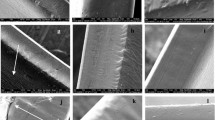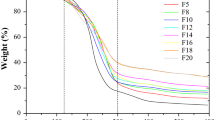Abstract
The mechanical properties, opacity, and water vapor permeability of 5.0 % (w/w) canola protein isolate (CPI) films were investigated in the presence and absence of 1 % (w/w of CPI) genipin, and as a function of plasticizer-type [50 % (w/w of CPI); glycerol, sorbitol, and polyethylene glycol 400]. Findings indicated that tensile strength (TS), puncture strength (PS), and elastic modulus (E) values for CPI films prepared with sorbitol were the highest, followed by PEG-400 and then glycerol, whereas tensile elongation (TE) and puncture deformation (PD) values were greater for films prepared with glycerol, followed by PEG-400 and then sorbitol. In all cases, films prepared with genipin were stronger (greater TS, PS, and E) and less flexible (lower TE and PD) than uncross-linked films. Films also showed greater water vapor permeability when prepared with glycerol, followed by PEG-400 and then sorbitol; however, no differences were observed in the presence and absence of genipin. Opacity was least with glycerol present, followed by sorbitol and PEG-400, and increased in the presence of genipin.





Similar content being viewed by others

References
Gontard N, Guilbert S, Cuq JL (1993) Water and glycerol as plasticizers affect mechanical and water vapor barrier properties of an edible wheat gluten film. J Food Sci 58:206–211
Kowalczyk D, Baraniak B (2011) Effects of plasticizers, pH and heating of film-forming solution on the properties of pea protein isolate films. J Food Eng 105:295–305
Rojas-Grau MA, Tapia MS, Rodriguez FJ, Carmona AJ, Martin-Belloso O (2007) Alginate and gellen based edible coatings are carriers of antibrowning agents applied on fresh-cut Fuji apples. Food Hydrocoll 21:118–127
Sebti I, Coma V (2002) Active edible polysaccharide coating and interactions between solution coating compounds. Carbohydr Polym 49:139–144
Han JH, Gennadios A (2005) In: Han JH (ed) Edible films and coating: a review. Elsevier Acad, New York
Janjarasskul T, Krochta JM (2010) Edible packaging materials. Annu Rev Food Sci Technol 1:415–448
Pruneda E, Hernandez-Peralta JM, Esquivel K, Lee SY, Godinez LA, Mendoza S (2008) Water vapor permeability, mechanical properties and antioxidant effect of Mexican oregano-soy based edible films. J Food Chem 73:C488–C493
Tang CH, Jiang Y, Wen QB, Yang XQ (2005) Effect of transglutaminase treatment on the properties of cast films of soy protein isolates. J Biotechnol 120:296–307
Orliac O, Rouilly A, Silvestre F, Rigal L (2003) Effects of various plasticizers on the mechanical properties, water resistance and aging of thermo-moulded films made from sunflower proteins. Ind Crops Prod 18:91–100
Saremnezhad S, Azizi MH, Barzegar M, Abbasi S, Ahmadi E (2011) Properties of a new edible film made of faba bean protein isolate. J Agric Sci Technol 13:181–192
Jang SA, Lim GO, Bin Song K (2011) Preparation and mechanical properties of edible rapeseed protein films. J Food Sci 76:C218–C223
Wu J, Muir AD (2008) Comparative structural, emulsifying, and biological properties of 2 major canola proteins, cruciferin and napin. J Food Sci 73:C210–C216
Uppstrom B (1995) In: Kimber S, McGregor DI (eds) Brassica oilseeds: production and utilization. England, Wallingford
Wanasundara JPD (2011) Proteins of Brassicaceae oilseeds and their potential as a plant protein source. Critical Rev in Food Science and Nutrition 51:635–677
Aluko RE, McIntosh T (2001) Polypeptide profile and functional properties of defatted meals and protein isolates of canola seeds. J Science of Food and Agriculture 81:391–396
Cao N, Yang X, Fu Y (2009) Effects of various plasticizers on mechanical and water vapor barrier properties of gelatin films. Food Hydrocoll 23:729–735
Gennadios A, Weller CL, Hanna MA, Froning GW (1996) Mechanical and barrier properties and egg albumen films. J Food Science 61:585–589
Mikkonen KS, Heikkinen S, Soovre A, Peura M, Serimaa R, Talja RA, Helen H, Hyvonen L, Tenkanen M (2009) Films from oat spelt arabinoxylan plasticized with glycerol and sorbitol. J Appl Polym Science 114:457–466
Gonzalez A, Strumia MC, Igarzabal CIA (2011) Cross-linked soy protein as material for biodegradable films: synthesis, characterization and biodegradation. J Food Engineering 106:331–338
Tang CH, Jiang Y (2007) Modulation of mechanical and surface hydrophobic properties of food protein films by transglutaminase treatment. Food Res International 40:504–509
Sothornvit R, Krochta JM (2001) Plasticizer effect on mechanical properties of beta-lactoglobulin in films. J Food Engineering 50:149–155
Song F, Zhang LM (2009) Gelation modification of soy protein isolate by a naturally occurring cross-linking agent and its potential biomedical application. Industrial & Engineering Chemistry Res 48:7077–7083
Touyama R, Takeda Y, Inoue K, Kawamura I, Yatsuzuka M, Ikumoto T, Shingu T, Yokoi T, Inouye H (1994) Studies on the blue pigments produced from genipin and methylamine. 1. Structures of the brownish-red pigments intermediates leading to the blue pigments. Chemical & Pharmaceutical Bull 42:668–673
Jin J, Song M, Hourston DJ (2004) Novel chitosan-based films cross-linked by genipin with improved physical properties. Biomacromolecules 5:162–168
Motta A, Barbato B, Foss C, Torricelli P, Migliaresi C (2011) Stabilization of Bombyx mori silk fibroin/sericin films by crosslinking with PEG-DE 600 and genipin. J Bioact Compat Polym 26:130–143
Folawiyo YL, Apenten RKO (1996) Effect of pH and ionic strength on the heat stability of rapeseed 12S (cruciferin) by the ANS fluorescence method. J Science of Food and Agriculture 70:241–246
Klassen DR, Elmer CM, Nickerson MT (2011) Associative phase separation involving canola protein isolate with both sulphated and carboxylated polysaccharides. Food Chem 126:1094–1101
Association of Official Analytical Chemists (AOAC) (1995) In: Cunniff P (ed) Official method 920.87—protein (total) in flour, final action. 16th edn. AOAC, Arlington
Barreto PLM, Pires ATN, Soldi V (2003) Thermal degradation of edible films based on milk proteins and gelatin in inert atmosphere. Polym Degrad Stab 79:147–152
Park SK, Bae DH, Rhee KC (2000) Soy biopolymers cross-linked with glutaraldehyde. J Am Oil Chem Soc 77:879–884
Chabanon G, Chevalot I, Framboisier X, Chenu S, Marc I (2007) Hydrolysis of rapeseed protein isolates: kinetics, characterization and functional properties of hydrolysates. Process Biochem 42:1419–1428
Wang XS, Tang CH, Yang XQ, Gao WR (2008) Characterization, amino acid composition and in vitro digestibility of hemp (Cannabis sativa L.) proteins. Food Chem 107:11–18
Gontard N, Duchez C, Cuq JL, Guilbert S (1994) Edible composite films of wheat gluten and lipids: water vapor permeability and other physical properties. International J. Food Science and Technology 29:39–50
ASTM E96–93 (1993) Annual book of ASTM standards. American Society for Testing & Materials, Philadelphia, PA
Gennadios A, Weller CL, Gooding CH (1994) Measurement errors in water vapor permeability of highly permeable, hydrophilic edible films. J Food Engineering 21:395–409
ASTM D882–91 (1991) Annual book of ASTM standards. American Society for Testing & Materials, Philadelphia, PA
Gontard N, Guilbert S, Cuq JL (1992) Edible wheat gluten films: influence of the main process variables on film properties using response surface methodology. J Food Science 57:190–199
Mangavel C, Barbot J, Gueguen J, Popineau Y (2003) Molecular determinants of the influence of hydrophilic plasticizers on the mechanical properties of cast wheat gluten. J Agricultural and Food Chemistry 51:1447–1452
Yang L, Paulson AT (2000) Mechanical and water vapor barrier properties of edible gellan films. Food Res International 33:563–570
Turhan KN, Sahbaz F, Guner A (2001) A spectrophotometric study of hydrogen bonding in methylcellulose-based edible films plasticized by polyethylene glycol. J Food Science 66:59–62
Ooi ZX, Ismail H, Abu Bakar A, Aziz NAA (2012) The comparison effect of sorbitol and glycerol as plasticizing agents on the properties of biodegradable polyvinyl alcohol/rambutan skin waste flour blends. Polym-Plastics Technology and Engineering 51:432–437
Liu C, Tellez-Garay AM, Castell-Perez ME (2004) Physical and mechanical properties of peanut protein films. LWT-Food Science and Technology 33:731–738
Wan VC, Kim MS, Lee S (2005) Water vapor permeability and mechanical properties of soy protein isolate edible films composed of difference plasticizer combinations. J Food Science 70:E387–E391
Butler MF, Ng YF, Pudney PDA (2003) Mechanism and kinetics of the crosslinkings reaction between biopolymers containing primary amine groups and genipin. J Polym Science Part A-Polym Chemistry 41:3941–3953
Mi FL, Sung HW, Shyu SS, Su CC, Peng CK (2003) Synthesis and characterization of biodegradable TPP/genipin co-crosslinked chitosan gel beads. Polym 44:6521–6530
Liang HC, Chang WH, Liang HF, Lee MH, Sung HW (2004) Crosslinking structure of gelatin hydrogels crosslinked with genipin or a water-soluble carbodiimide. J Appl Polym Science 91:4017–4026
Okamoto S (1978) Factors affecting protein film formation. Cereal Foods World 23:256–262
Gennadios A, McHugh TH, Weller CL, Krochta JM (1994) In: Krochta JM, Baldwin EA, Nisperos-Carriedo M (eds) Edible coatings and films based on proteins. Technomic Publishing Company, Inc., Lancaster, PA
Lieberma ER, Gilbert SG (1973) Gas permeation of collagen films as affected by crosslinkage, moisture, and plasticizer content. J Polym Science Part C-Polym Symposium 41:33–43
Cheng LH, Abd Karim A, Seow CC (2006) Effects of water-glycerol and water sorbitol interactions on the physical properties of konjac glucomannan films. J Food Science 71:E62–E67
Rockland LB (1984) Moisture sorption-practical aspects of isotherm measurement and use—Labuza. T. P. Food Technology 3:112
McHugh TH, Krochta JM (1994) In: Krochta JM, Baldwin EA, Nisperos-Carriedo M (eds) Permeability properties of edible films. Technomic Publishing Co., Lancaster, PA
Sothornvit R, Krochta JM (2000) Plasticizer effect on oxygen permeability of beta-lactoglobulin films. J Agricultural and Food Chemistry 48:6298–6302
Acknowledgments
Financial support for this research was provided by the Saskatchewan Canola Development Commission and the Saskatchewan Ministry of Agriculture Development Fund.
Conflict of interest
None.
Compliance with Ethics Requirements
This article does not contain any studies with human or animal subjects.
Author information
Authors and Affiliations
Corresponding author
Rights and permissions
About this article
Cite this article
Chang, C., Nickerson, M.T. Effect of plasticizer-type and genipin on the mechanical, optical, and water vapor barrier properties of canola protein isolate-based edible films. Eur Food Res Technol 238, 35–46 (2014). https://doi.org/10.1007/s00217-013-2075-x
Received:
Revised:
Accepted:
Published:
Issue Date:
DOI: https://doi.org/10.1007/s00217-013-2075-x



